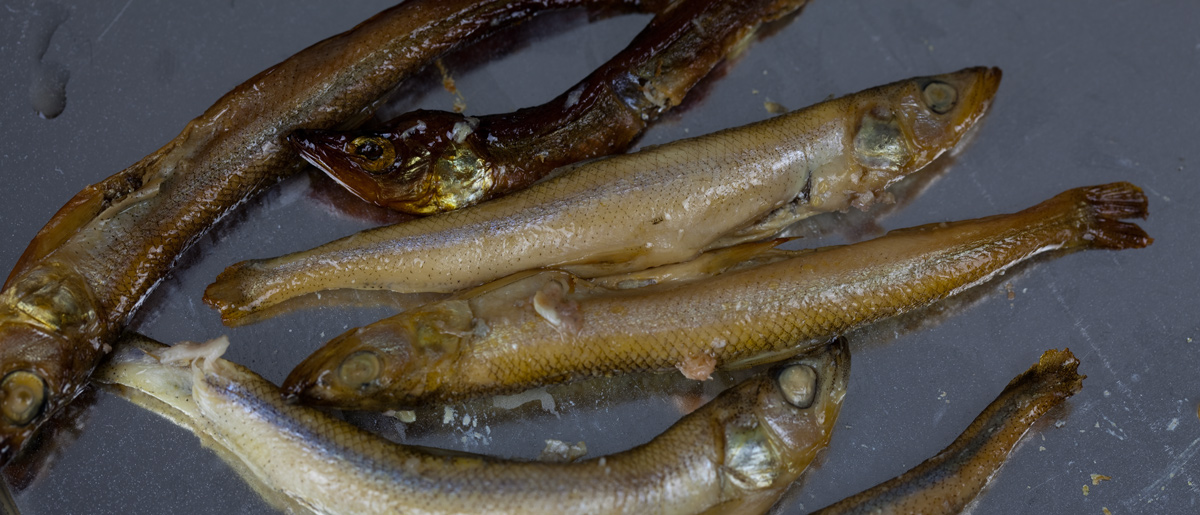Fort Clatsop, OR Coboway and two of his children bring cooked eulachon to Fort Clatsop, pleasing the captains. Detachments are sent to hunt and fish, several men are sick, and Lewis lists the aquatic birds of the area.
Comowool (Coboway) with Anchovies[1]Originally aired weekdays by Yellowstone Public Radio during the Bicentennial observance of 2003-2006. Narrated by Hal Hansen. Scripts by Whit Hansen and Ed Jacobson. Produced by Leni Holliman. © … Continue reading
Smoked Eulachon
© 2011 by Kristopher K. Townsend. Permission to use granted under the Creative Commons Attribution-Share Alike 4.0 International license.
Coboway and Sons
we were visited by Commowoll [Coboway] and two boys Sons of his. he presented us with Some Anchovies which had been well Cured in their manner, we found them excellent. they were very acceptable perticularly at this moment. we gave the old mans Sones a twisted wire to ware about his neck, and I gave him a par of old glovs which he was much pleased with. this we have found much the most friendly and decent Indian that we have met with in this neighbourhood.
—Meriwether Lewis
Searching for Provisions
Our stock of provisions being nearly exhuasted, six men were sent out in different directions to hunt, and three more were sent to endeavour to procure some fish, as the natives take a great number of the small fish about 20 miles distant from the fort by water. Some men were also employed in repairing the canoes, that we may be able to set out on our return immediately, should our hunters be unsuccessful. The elk, almost the only game in this part of the country, are chiefly gone to the mountains.
—Patrick Gass
Sick Men
Hall had his foot and ankle much injured yesterday by the fall of a large stick of timber; the bones were fortunately not broken and I expect he will be able to walk again shortly. Bratton is now weaker than any of the convalessants, all of whom recover slowly in consequence of the want of proper diet, which we have it not in our power to procure.—
—Meriwether Lewis
Aquatic Birds
The Aquatic birds of this country, or such as obtain their subsistence from the water, are the large blue and brown heron, fishing hawk, blue crested fisher, gulls of several species of the Coast, the large grey gull of the Columbia, Cormorant, loons of two species, white, and the brown brant, small and large geese, small and large Swan, the Duckinmallard, canvis back duck, red headed fishing duck, black and white duck, little brown duck, black duck, two species of divers, blue winged teal, and some other speceis of ducks.
—Meriwether Lewis
Weather Diary
Aspect of the weather at Rise
Wind at rise
Aspect of weather at 4 O’Ck P. M. Wind at 4 OCk. P. M. fair after rain S E cloudy after fair S E altho’ it is stated to be fair this morning the sun is so dim that no observations can be made Saw a spider this morning, tho’ the air is perceptably colder than it has been since the 1st inst.— at 9 A. M. it clouded up and continued so the ballance of the day. even the Easterly winds which have heretofore given us the only fair weather which we have enjoyed seem now to have lost their influence in this rispect.—
—Meriwether Lewis[2]To assist the reader, the editor of this web page has omitted the “Day of the Month” column and spelled out some abbreviations.
Fort Clatsop is a High Potential Historic Site along the Lewis and Clark National Historic Trail managed by the U.S. National Park Service. The site is managed by the Lewis and Clark National and State Historic Parks.
Notes
| ↑1 | Originally aired weekdays by Yellowstone Public Radio during the Bicentennial observance of 2003-2006. Narrated by Hal Hansen. Scripts by Whit Hansen and Ed Jacobson. Produced by Leni Holliman. © 2003 by Yellowstone Public Radio. |
|---|---|
| ↑2 | To assist the reader, the editor of this web page has omitted the “Day of the Month” column and spelled out some abbreviations. |



